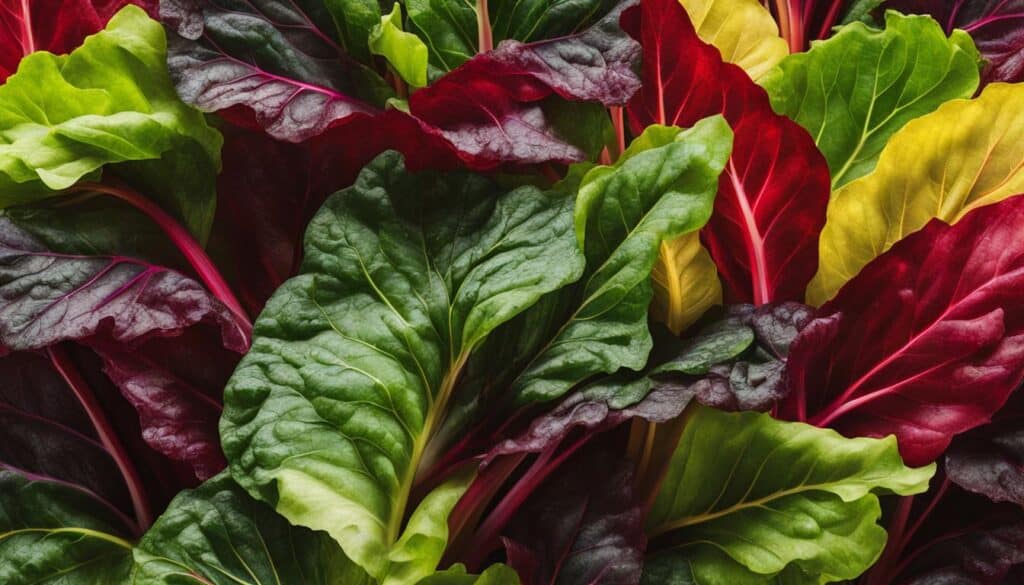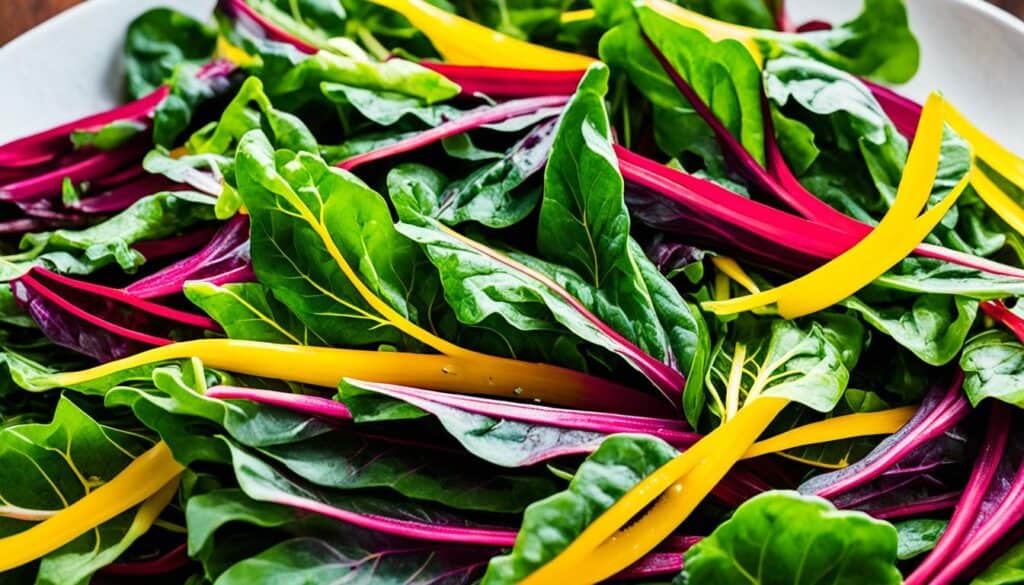Did you know that rainbow chard, also known as Swiss chard, comes in a variety of vibrant colors, including yellow, orange, red, pink, and purple? Not only does it add a burst of color to your garden, but rainbow chard also offers a myriad of health benefits. Packed with vitamins A and C, as well as minerals like potassium, iron, calcium, and magnesium, it’s a real nutritional powerhouse that can elevate your meals to a whole new level.
Key Takeaways:
- Rainbow chard is a colorful and nutritious vegetable that is easy to grow in your garden.
- It comes in vibrant colors such as yellow, orange, red, pink, and purple.
- Rich in vitamins and minerals, rainbow chard offers a range of health benefits.
- Regular harvesting ensures the best flavor and continuous growth of rainbow chard.
- You can enjoy rainbow chard in a variety of delicious recipes, from salads to sautés.
Planting Rainbow Chard: Tips and Tricks
Planting rainbow chard is a simple process that requires a sunny location and average garden soil or a large container. It can be grown from seeds or small plants.
- Prepare the soil: Start by digging to a depth of 8-12 inches. This will loosen the soil, making it easier for the chard’s roots to grow. Mix in some compost to improve the soil’s fertility, and add a starter fertilizer to provide nutrients for healthy plant growth.
- Plant the seeds: If growing from seeds, plant them about ½-inch deep in the soil. Space them three inches apart in a row. Alternatively, if using small plants, dig a hole large enough to accommodate the roots, ensuring the crown is level with the soil surface.
- Thin the plants: When the young chard plants reach six inches tall, thin them to one foot apart. This will give each plant enough space to grow and thrive.
- Water and fertilize: Water the plants regularly to keep the soil moist but not waterlogged. Be mindful not to overwater, as excessive moisture can lead to root rot. After two months, lightly fertilize the plants to provide additional nutrients for healthy growth.
Rainbow chard typically takes 60-90 days to reach maturity, depending on the weather conditions. Regular watering, adequate sunlight, and proper care will ensure a bountiful harvest of these vibrant and nutritious greens.
Care and Maintenance of Rainbow Chard
Taking care of rainbow chard is relatively easy. It’s important to provide the right conditions for the plants to thrive and ensure a bountiful harvest. Here are some essential tips on how to care for rainbow chard:
1. Watering:
Keep the soil moist but avoid overwatering. Rainbow chard requires regular watering, especially during hot and dry periods. Ensure the soil is consistently damp, but not waterlogged, to prevent root rot.
2. Mulching:
Mulching around the plants can help retain moisture in the soil and suppress weed growth. Apply a layer of organic mulch, such as straw or shredded leaves, around the base of the plants. This will also help regulate soil temperature and reduce water evaporation.
3. Pest Control:
Watch out for common pests that can affect rainbow chard, such as aphids and leaf miners. These pests can damage the leaves and hinder the plant’s growth. Take preventive measures, such as using row covers or organic insecticides, to keep the pests at bay and protect your plants.
4. Harvesting:
Regular harvesting is crucial for maintaining the best flavor and continuous growth of rainbow chard. Start harvesting the outer leaves when they reach a suitable size, usually around 6-8 inches tall. Leave the inner leaves to mature and continue growing. Harvesting the leaves also prevents the plants from bolting and producing a seed stalk.
Remember to enjoy the beauty of rainbow chard while taking care of it. The vibrant colors of the leaves will add visual appeal to your garden, and the nutritious harvest will be a delightful addition to your meals. With proper care and attention, rainbow chard will thrive and reward you with a bountiful harvest.
Harvesting Rainbow Chard: Tips and Techniques
Harvesting rainbow chard is a simple and rewarding process that allows you to enjoy the vibrant flavors and colors of this nutritious vegetable. To ensure the best flavor and quality, it’s important to harvest rainbow chard at the right time and using proper techniques.
When harvesting rainbow chard, you have two options: breaking away or cutting off the fully grown leaves near the base of the plant. Both methods work well, so choose the one that suits your preference. Just make sure to handle the leaves gently to avoid damaging the plant.
To maintain the longevity of the plant and prevent the leaves from becoming tough and stringy, it’s crucial to regularly harvest the outer leaves. These leaves are the oldest and will be the most flavorful. By removing them, you allow the younger leaves in the center of the plant to continue growing and replenish the harvest.
Remember, harvesting rainbow chard is an ongoing process. As long as you keep harvesting the outer leaves, new ones will continue to grow from the center, providing you with a continuous supply of fresh and delicious foliage throughout the growing season.
“Regularly harvesting the outer leaves ensures that your rainbow chard plants will keep producing fresh and tender leaves for an extended period. It’s like having a never-ending supply of nutritious and colorful greens!”
It’s important to monitor your plants closely for signs of bolting. Bolting occurs when the plant starts to produce a seed stalk, indicating that it has reached the end of its life cycle. When this happens, it’s time to harvest all the remaining good leaves and remove the plant from the garden. This prevents the leaves from becoming bitter and unpalatable.
Quick Tips for Harvesting Rainbow Chard:
- Harvest the outer leaves regularly to encourage new growth.
- Handle the leaves gently to avoid damaging the plant.
- Check for signs of bolting and remove the plant when necessary.
- Harvest in the morning when the leaves are crisp and full of moisture.
- Wash the harvested rainbow chard leaves thoroughly before using them.
By following these simple tips and techniques, you’ll be able to enjoy the vibrant beauty and delicious taste of freshly harvested rainbow chard in your favorite recipes.
Nutritional Benefits of Rainbow Chard
Rainbow chard is not only visually appealing but also highly nutritious. It is an excellent source of vitamins A and C, which are essential for immune function and skin health. Rainbow chard is also rich in minerals like potassium, iron, calcium, and magnesium, which are important for maintaining healthy bones and muscles. Additionally, it is low in calories and high in fiber, making it a great choice for those watching their weight. Adding rainbow chard to your diet can provide a wide range of health benefits.
“Rainbow chard is not only visually appealing but also highly nutritious.”
Nutrition Facts of Rainbow Chard
To truly understand the health benefits of rainbow chard, let’s take a look at its nutrition facts:
| Nutrient | Amount per 100g |
|---|---|
| Calories | 19 |
| Protein | 1.8g |
| Fat | 0.2g |
| Carbohydrates | 3.6g |
| Fiber | 1.6g |
| Vitamin A | 6115IU |
| Vitamin C | 30mg |
| Potassium | 379mg |
| Iron | 2.2mg |
| Calcium | 51mg |
| Magnesium | 81mg |
As you can see, rainbow chard is a nutrient-dense vegetable that can support your overall health and well-being. With its low calorie count and high fiber content, it can aid in weight management and promote digestive health. The vitamins and minerals in rainbow chard contribute to immune function, bone strength, and muscle health. Including rainbow chard in your meals is a delicious way to boost your nutrient intake and support a healthy lifestyle.
Cooking with Rainbow Chard: Delicious Recipes
Rainbow chard is a versatile vegetable that can be used in a variety of delicious recipes. Its vibrant colors and mild flavor add both visual appeal and taste to any dish. Here are some creative ways to incorporate rainbow chard into your cooking:
- Rainbow Chard Salad: Create a refreshing and healthy salad by chopping rainbow chard leaves into bite-sized pieces. Toss them with your favorite salad ingredients like tomatoes, cucumbers, and avocados. Top it off with a light dressing of olive oil and lemon juice for a burst of freshness.
- Sautéed Rainbow Chard: Heat some olive oil in a pan and sauté chopped rainbow chard with garlic until it wilts. Season with salt and pepper to taste. This quick and easy side dish pairs well with grilled meats or roasted vegetables.
- Rainbow Chard Quiche: Use rainbow chard as a filling in a savory quiche. Sauté the chard with onions and garlic, then mix it with beaten eggs, milk, cheese, and your favorite herbs. Pour the mixture into a pie crust and bake until golden brown.
- Rainbow Chard Smoothie: Blend rainbow chard leaves with your favorite fruits, such as berries, bananas, and oranges, for a nutritious and vibrant smoothie. Add a splash of almond milk or yogurt for a creamy texture.
- Rainbow Chard Soup: Cook rainbow chard leaves in a flavorful broth with other vegetables like carrots, celery, and onions. Season with herbs and spices, and let it simmer until all the flavors meld together. Serve hot with crusty bread for a comforting meal.
These are just a few examples of the many ways you can enjoy cooking with rainbow chard. Get creative in the kitchen and experiment with different recipes to discover your favorite dishes featuring this nutritious and colorful vegetable.
Rainbow Chard Salad: A Refreshing and Healthy Option
If you’re looking for a refreshing and healthy salad option, rainbow chard salad is the way to go. This vibrant and nutrient-packed dish is not only delicious but also incredibly easy to prepare. All you need to do is chop the rainbow chard leaves into bite-sized pieces and mix them with your favorite salad ingredients.
For added flavor and texture, consider adding a variety of toppings to your rainbow chard salad. Nuts, seeds, feta cheese, and dried fruits are all excellent choices that will enhance the overall taste. These toppings also provide extra nutrients and add a delightful crunch to every bite.
To bring everything together, drizzle your rainbow chard salad with a light dressing made with olive oil and lemon juice. The combination of these fresh and zesty flavors perfectly complements the earthy taste of the rainbow chard.
Finally, season your salad with salt and pepper to taste. This simple touch enhances the flavors and ensures that every mouthful is bursting with deliciousness.
Not only is rainbow chard salad a tasty treat, but it is also packed with essential nutrients. Rainbow chard is a great source of vitamins and minerals, including vitamins A and C, calcium, iron, and potassium. By incorporating this colorful leafy green into your diet, you can enjoy a refreshing and healthy meal that nourishes your body.
So why not try making a rainbow chard salad today? It’s a light and satisfying dish that will leave you feeling energized and nourished.
Discover the Benefits of Rainbow Chard Salad:
- Refreshing and flavorful
- Packed with vitamins and minerals
- Easy to prepare
- Versatile and customizable
- A great option for a light meal or side dish
Try this Rainbow Chard Salad Recipe:
| Ingredients | Instructions |
|---|---|
| 1 bunch of rainbow chard | 1. Wash the rainbow chard thoroughly and pat dry. |
| Your favorite salad ingredients (e.g., cherry tomatoes, cucumber, avocado) | 2. Chop the rainbow chard leaves into bite-sized pieces. |
| Toppings of your choice (e.g., nuts, seeds, feta cheese, dried fruits) | 3. Mix the rainbow chard with your favorite salad ingredients. |
| Light dressing of olive oil and lemon juice | 4. Drizzle the salad with a light dressing of olive oil and lemon juice. |
| Salt and pepper to taste | 5. Season with salt and pepper to taste. |
Enjoy your homemade rainbow chard salad and savor the vibrant flavors and health benefits it brings to your table.
The Many Varieties of Rainbow Chard
Rainbow chard comes in various varieties, each offering its own unique colors and characteristics. While the standard varieties of chard feature dark green foliage and white stalks, there are some exciting alternatives to explore. The most popular variety among gardeners is ‘Bright Lights’, known for its stunning array of colors. Its leaves range from vibrant green to rich burgundy, while the stalks come in various shades of yellow, orange, red, pink, and purple. Another eye-catching variety is ‘Rhubarb’, which boasts reddish-green leaves and bright red stems. The different varieties of rainbow chard bring a vibrant touch to both your garden and your meals.
To help you visualize the variety of rainbow chard, take a look at the table below:
| Variety | Leaf Color | Stalk Color |
|---|---|---|
| Bright Lights | Green to Burgundy | Yellow, Orange, Red, Pink, Purple |
| Rhubarb | Reddish-Green | Bright Red |
Conclusion
Rainbow chard is a vibrant and nutritious vegetable that will delight both your eyes and taste buds. Its stunning array of colors, including yellow, orange, red, pink, and purple, adds a beautiful touch to any garden. Not only is rainbow chard visually appealing, but it also offers a wealth of health benefits. Packed with vitamins A and C, as well as essential minerals like potassium, iron, calcium, and magnesium, this leafy green is a powerhouse of nutrition.
Whether you’re a beginner or an experienced gardener, rainbow chard is an excellent choice for growing in your garden. It requires minimal care and can thrive in both sunny garden beds and spacious containers. With its quick growth and easy maintenance, you’ll be rewarded with a bountiful harvest in no time.
Regular harvesting is key to the continuous growth and flavor of rainbow chard. By harvesting the outer leaves as they mature, you can encourage new growth from the center, ensuring a steady supply of fresh, tender leaves. Add rainbow chard to your favorite recipes, such as salads, sautés, and soups, or simply enjoy it raw for a crisp and nutritious boost.
So why wait? Start growing rainbow chard today and experience the joy of cultivating your own vibrant and nutritious vegetable. Whether you’re looking to enhance the visual appeal of your garden or add a nutritious twist to your meals, rainbow chard is the perfect choice.










Leave a Reply